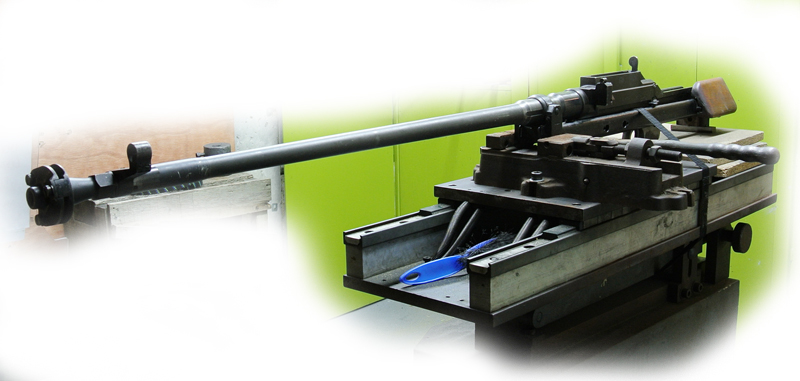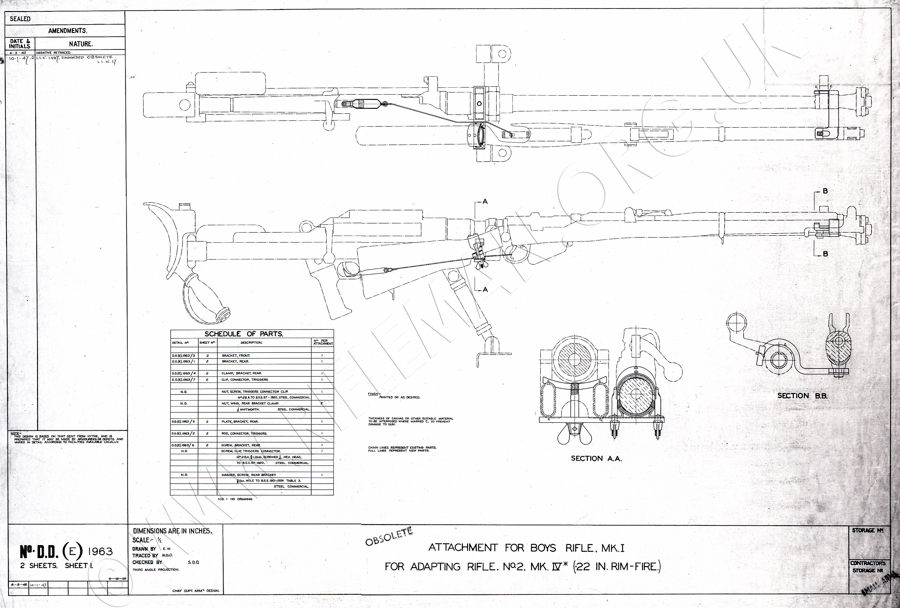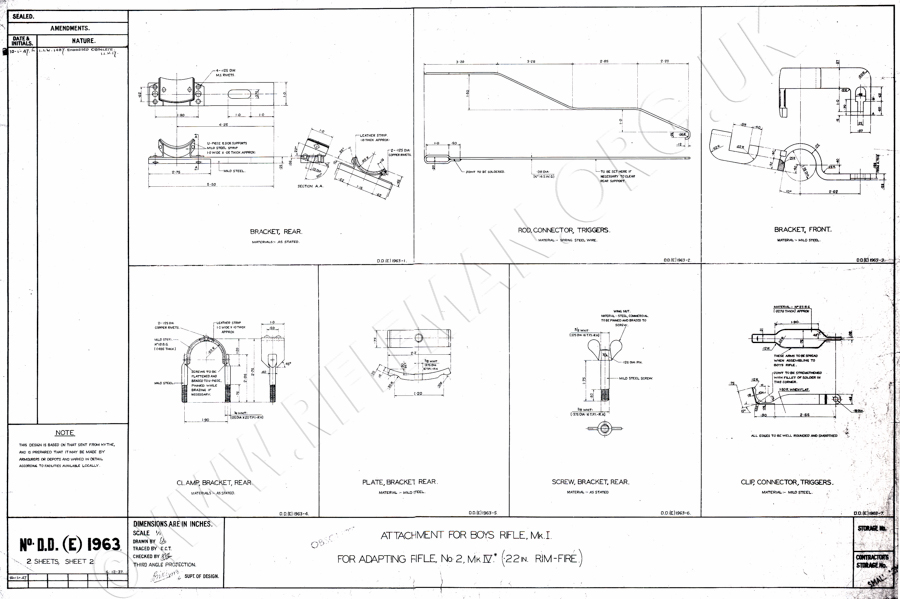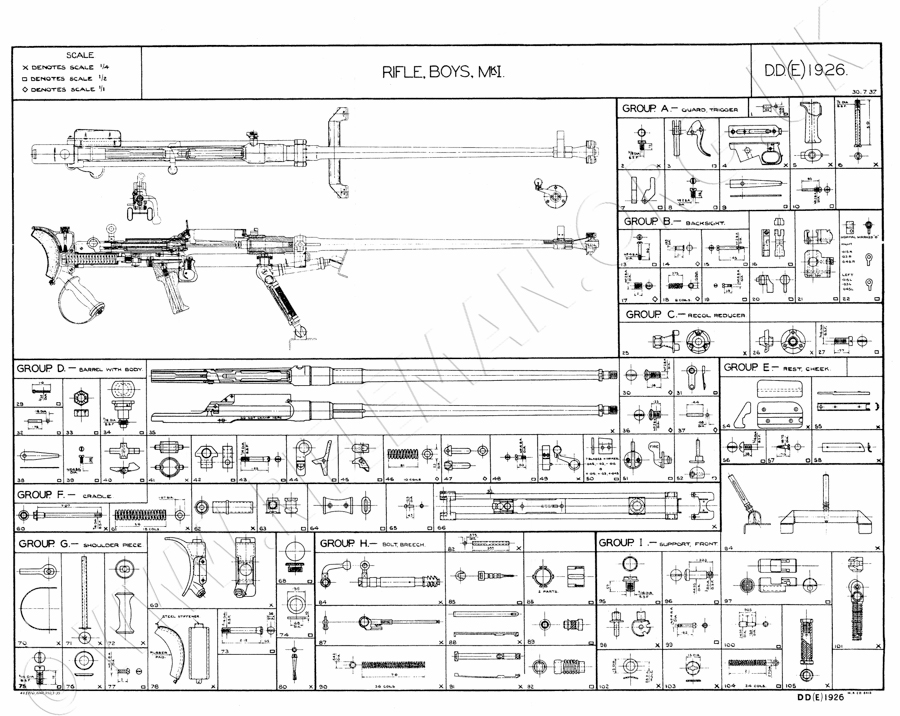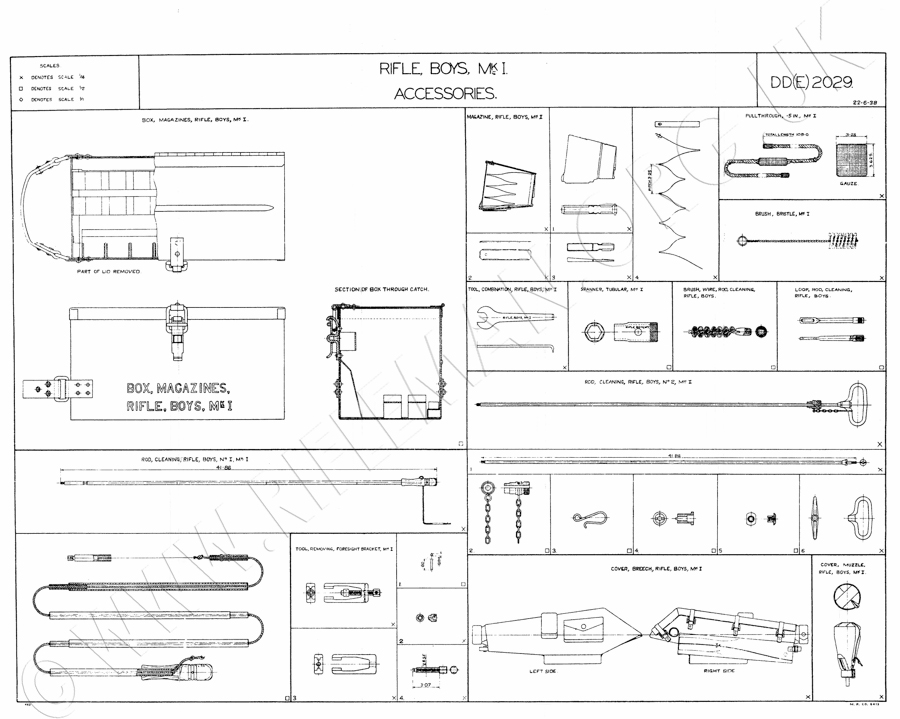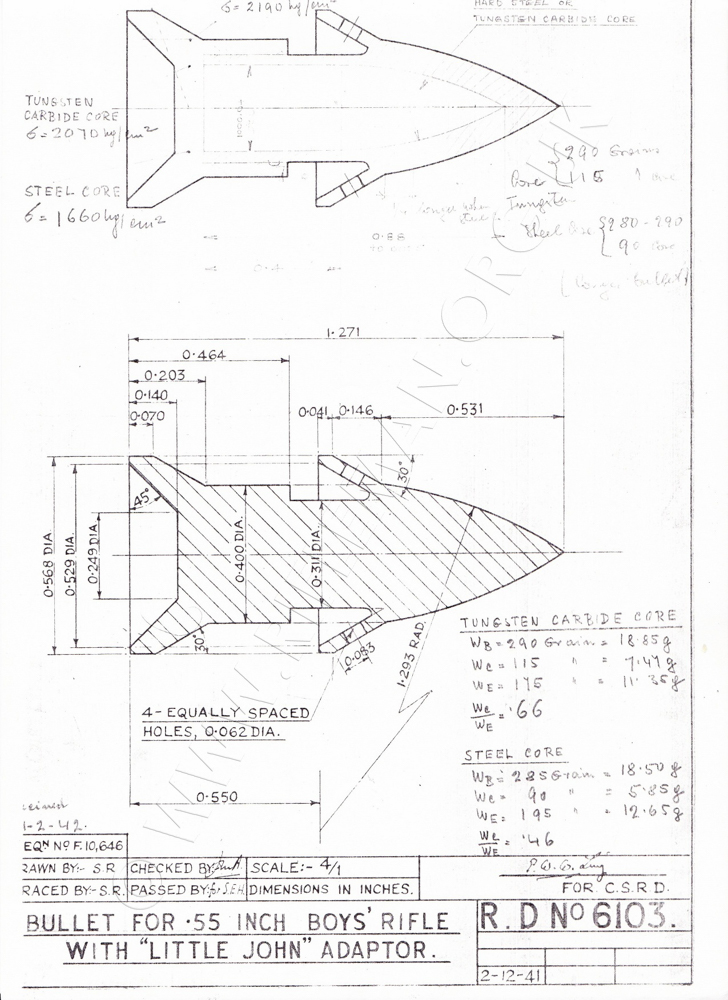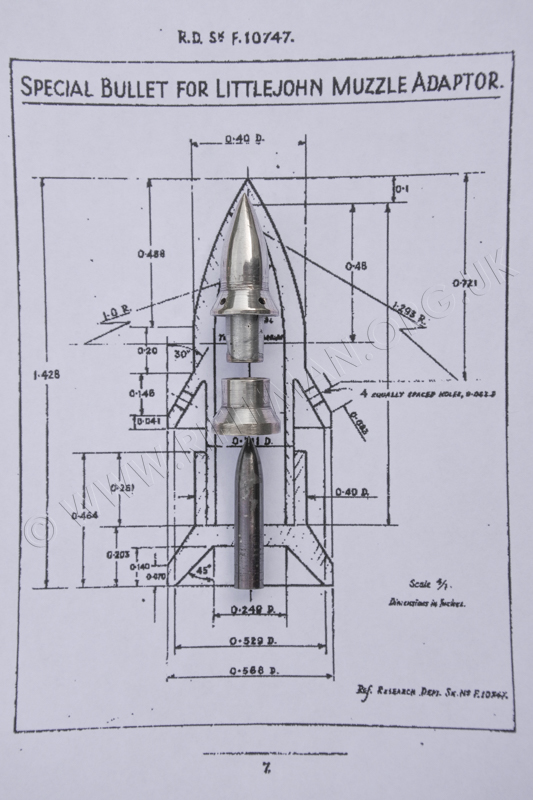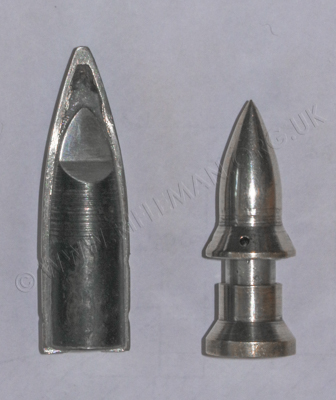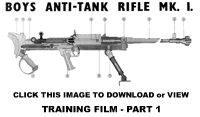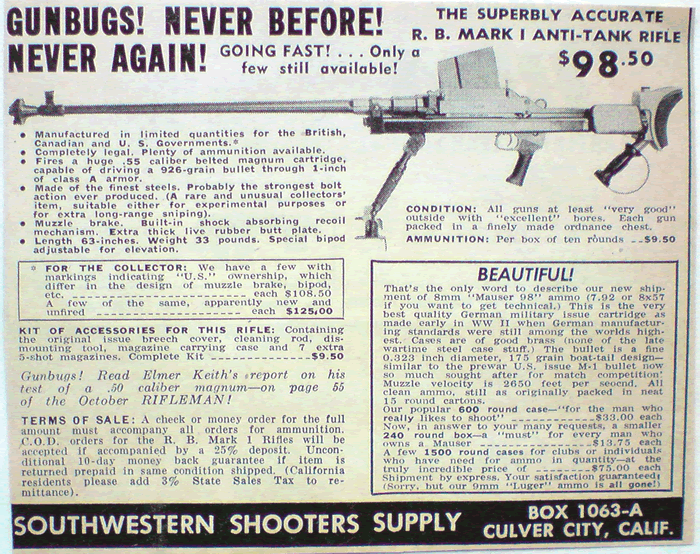BOYS ANTI-TANK RIFLE and VARIANTS
in .55-inch, .50BMG, .303-inch and .22RF calibres
Designed at the Enfield Royal Small Arms Factory
Please be aware that some specialist imagery may take time to load.
This site is for dedicated researchers and is best viewed on desktop.
AND DIRECTLY RELATED TO THIS PAGE'S SUBJECT RIFLE
BOYS ATR .55/.303 CALIBRE..-..BOYS ATR SAVAGE SUB-CALIBRE. - .BOYS "LITTLEJOHN" ADAPTATION
BOYS ATR S.M.L.E. SUB-CALIBRE ....- .....BOYS ATR AIRBORNE MODEL..... - .... .55-cum-.22 ADAPTER
and associated literature
BOYS ATR - MANUAL..... - .... SAT PAMPHLET No.5..... - .... RANGE COURSE .....
.ILLUSTRATED PARTS LIST..... - ....ARMOURERS' INSTRUCTIONS..... - ....BOYS ATR List of Changes
A .55 calibre anti-tank rifle may seem rather out of context on a website covering miniature calibre rifles, but there is method in our madness: after all, our remit includes British rifles, with a particular representation of Enfield products, as well as small-bore rifles of B.S.A. manufacture, which have a major part to play in our research.
(See also the Birmingham Small Arms Co.)
We endeavour to include sub-calibre equipments associated with the rifles represented on-site, because these relate to the training theme; and the Boys Anti-Tank Rifle above all others certainly required sub-calibre adaptors, particularly because ranges on which such a rifle could safely be fired have always been comparatively small in number, even in war-time.
The rifle shown below is of B.S.A. original manufacture in .55-in. calibre (13.9 mm), but has been converted to U.S. Browning .50-in calibre as described further on in this page. For comparison, it is photographed alongside a Canadian C. No.7 rifle, the Canadian conversion of the Lee-Enfield No.4 rifle to .22 rim-fire calibre as a training rifle. Stood to the right are both a .50 calibre round and a .303in. standard service rifle calibre round.
The British made rifles were produced at B.S.A.'s Small Heath factory in Birmingham. The rifle weighs 36 lbs., is 63.5 inches overall in length, and has a 36" barrel with 7-groove rifling.
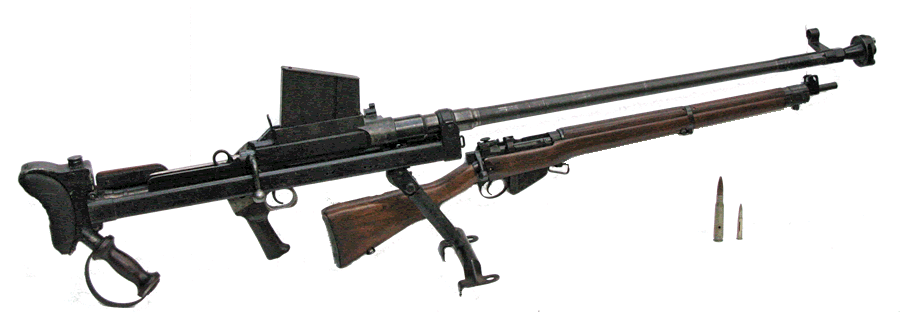
We will afford here but a potted history of the "Boys", since its fame is widespread and much has been written elsewhere which hardly needs repeating. We are, however, replicating such printed matter as was contemporary to the rifle's issue, and which has now joined the public domain. We include the rifle's manual published by Gale & Polden, as well as the Small Arms Training (SAT) Pamphlet No. 5 covering the use of the rifle, and the appropriate section from Pamphlet No.18 dealing with War-time Range Courses, although this does duplicate some of the information in the manual.
Being somewhat lengthy, these items of literature are on separate pages linked from here.
BOYS ATR - MANUAL ... SAT PAMPHLET No.5 ..... RANGE COURSE ......ILLUSTRATED PARTS LIST......ARMOURERS' INSTRUCTIONS
More detailed images of the rifle are included below and, towards the bottom of the page, in video clips, are the three parts of a training film for the Boys Anti-Tank rifle, produced circa 1942 by Walt Disney's film company in America, as well as a short Movietone news reel of the rifle being fired against traversing targets by British soldiers in training during 1940.
The 'Boys' rifle was designed at the Royal Small Arms Factory at Enfield in Middlesex, which town had been the home of all things military in British small-arms and explosives manufacture since the commencement, in 1812, of centralised production until its closure in 1988 and removal to Nottingham. The later Nottingham site was itself closed only a few short years ago.
Leader of the the ATR design team at Enfield Lock was the Assistant Superintendent of Design, Capt. H.C. Boys, who conceived the basic concept for the rifle from a meld of the U.S. .50 calibre round and the required specification for the new rifle, which eventually bore more than a little resemblance to the .303 calibre Bren Light Machine Gun (LMG).
The very first use of a rifle specifically against tanks was in the First World War after the British fielded their new tanks to the battlefields of France and Belgium. Germany was initially quick to react with an uploaded armour-piercing cored spitzer round (S.m.K. Spitzgeschoß mit Kern) for their standard Mauser rifle, but soon brought a purpose-designed large-calibre 13.2mm rifle into play - the Tank Abwehr Gewehr M1918.
Between the two World Wars, early in 1932, a requirement was perceived for an up-to-date British anti-tank rifle, and design work was initiated in 1934, with trialling early in 1936 and first issue in the following year.
Below is an image of the LHS of the Boys, showing the diminutive walnut cheek-piece, on which a firer is advised to rest his chin/cheek as far forward as possible to avoid injury on firing, as well as the screw-lid of the oil-bottle fitted into the butt-plate. The lid has it own convenient oil brush affixed, so no excuses here then! The heavy covered rubber recoil-pad can be seen attached to the butt-plate.
For scale assessment, a practice .50 calibre Browning round is laid on the groove in the bolt's ejector bar. At the rear of the magazine is the spring-loaded magazine release lever - push forward to release. When the lever is pushed forward and the magazine removed, there is a small button at the base of the release lever which has to be pressed to permit withdrawal of the bolt. The bolt cannot be closed with the magazine empty. It is just possible to make out the recoil absorption system allowing the barrel and action to slide rearwards in the frame on firing. This comprises of a large spring held centrally within the lower frame with a back-stop within the butt-plate, and its front end engaging with the action. The rearward movement is of the order of an inch. The barrel reinforce slides within the 'scope-mount-like' clamped loop casting affixed to the front of the frame.
Both the lower part of the pistol-grip and the spindle grip of the rear hand-hold are manufactured in walnut.

Originally given the name "Stanchion", and prototyped under that nomenclature, the rifle was renamed Boys, as a tribute to the man who brought it into being, after his unexpected death which occurred before the rifle was even brought into service in November 1937.
The Stanchion was at first trialled in .50 calibre with the Boys belted case, but, after what has been described as "a disappointing armour-piercing performance", the calibre was " upped to .55inch ".
We have been fortunate to locate an early report made on the rifle in January 1937. This gives penetration and range figures, and comments on many factors relevant to anti-tank small arms at that time, giving comparisons with the Swiss Solothurn rifle and the Oerlikon gun. It is interesting to note that the recoil is described as being similar to that of a shotgun. This was later rather belied by the nicknames afforded the rifle by those by whom it had to be used in the field, not to mention descriptions of its use and performance given by the infantrymen who had to carry and fire it.
The Boys ATR was compared with the Swiss Solothurn rifle and the Oerlikon gun that were contemporarily in use for anti-armour purposes. This subject is also later covered in 1939 Ordnance Board Directive memoranda reproduced further down this page.
The 1937 report may be viewed in portrait or as flip-pages by clicking the appropriate icon.
Depending upon the number of pages they may take a few moments to load.
Double tap tablet or click
TEST FIRING THE BOYS ANTI-TANK RIFLE
This was done with the kind assistance of the Kynoch Ammunition Company (Kynamco) at their underground facility in Norfolk.
The first section is filmed in real time with momentary freeze-frames on ignition. This is followed by a similarly treated 400 fps (frames per second) slo-mo, and then a 1200 fps clip. As the camera speed increases, of necessity the resolution quality reduces.
Anyone familiar with these rifles and their ammunition may spot something unusual in the video. Congratulations if you noticed, before reading this footnote, that this particular rifle has been modified by fitment of a .50 calibre barrel, as was the case with some of those rifles used by the US Rangers. The round seen standing beside the rifle is therefore not a .55inch Boys cartridge, but a .50 calibre BMG round (Browning Machine Gun).
The chief aspect which brings the Boys ATR to our attention relates to the training of those to whom it fell, as a demanding duty, to carry and use this 36 lb. weapon and its heavy ammunition in battle areas. Such soldiers have been heard to understate selection for this duty as 'unpopular', with good reason; but when successful in actions of manifold type, from its basic intended purpose of disabling Armoured Fighting Vehicles, to attacking machine gun nests and pill boxes, and latterly long-range anti-personnel operations, then it was viewed with much improved popularity.
One New Zealander, in the Middle East during the War, wrote afterwards
"There were no troops behind us all the way to Alexandria while up forward there was only a small garrison at Mersa Matruh and nothing much in the way of troops or armour in the desert west of there….
We had no wire, no minefields, no artillery and we had not had a tremendous amount of practice with our rifles. We had an anti-tank rifle which temporarily incapacitated the firer at every shot, plus three brens and a lewis gun."*
Another internet article reports the Boys ATR as acquiring the unsubstantiated nickname "Charlie the bastard" due to its painful recoil. It is highly likely that any number of equivalent representative names were also used for the weapon, which was far better employed on some manner of mounting than as a free-standing rifle.
However, in its task of AFV destruction, apart from its use against the thinly armoured Japanese light tanks in the Pacific theatre, German improvements and modifications to armour rendered the Boys almost ineffective in Europe within the first eighteen months of the War.
It became necessary to use techniques such as shooting at the joint between a tank's turret and main body in an attempt to jam the turret rotation mechanism, or to shoot at track links, gears or wheels. The rifle did at least prove effective in the latter method, but this had a tendency to leave the ATR firer at the mercy of the tank's gun crew.
That some aspects of performance and handling of the the rifle left much to be desired became evident during the year after its introduction. Even six months prior to the declaration of War against Germany by Britain on, 1st. September 1939, deficiencies in both penetration and accuracy had already been noted, and remedies were being considered, by the Ordnance Board.
Improvements in the Armour Piercing ammunition were sought, as well as a means to facilitate the somewhat awkward traversing of the rifle on its Mark I monopod support. Many proposed amendments and recommendations were made early in 1939, and these were included in a series of secret memoranda issued by the Ordnance Board as OBDs (Ordnance Board Directives).
The possibility of the rifle's use for sniping was covered, and the report ends with a German contemporary assessment with photographs.
Below is a searchable facsimile of the document,
which may take a few moments to display.
Since the Boys was devised for use against mobile targets, the critical need in training was to teach correct assessment of 'lead' on those targets. Obviously, a target moving directly towards, or away from, the ATR firer has only altering range, and no lateral movement of the rifle is required when aiming. More often, a target was moving at an angle in relation to the firer, requiring lateral adjustment of the aim to accommodate varying speeds and angles of approach or retirement.
Teaching and practising this with the full-bore .55 calibre armour-piercing round was only possible in a few locations. However, ingenious use of sub-calibre equipment could provide the training necessary, and be undertaken almost anywhere with a backstop suitable for the .22 rimfire round.
Two main systems were developed, the earlier and most quickly produced method being that shown below. The image below illustrates the attachment of a .22 rimfire calibre S.M.L.E. rifle for practice with the "Boys" on a miniature range, usually of either 25 or 30 yards. The .22 training rifle used is most likely to have been either a Lee-Enfield No.2 Mk.IV* or a .22RF Mk.III.
This method of attaching a lesser calibre rifle to the parent arm for sub-calibre practice was nothing new, and had been employed with artillery pieces for many years.
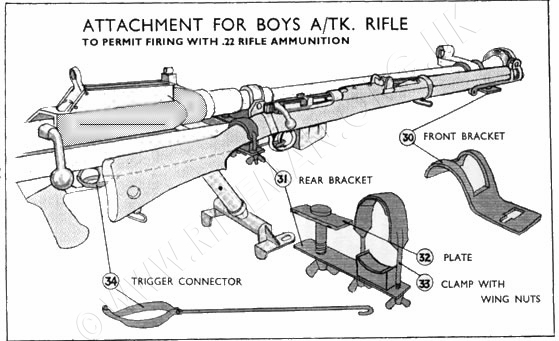
There was an appendix subsequently added to Australian edition of the original 1937 Small Arms Training pamphlet, which described the method of attachment of the .22 SMLE rifle to the Boys ATRmanual. The instructions were as follows -
Appendix III.—Attachment for A.Tk. Rifle for Adapting a .22-in. Rifle
Instructions for the use and assembly of the attachment.
General.—In order to economize on the expenditure of •55-in. ammunition during instruction, this device has been designed to attach a .22-in. cal. rifle to the service A.Tk, rifle in such a manner that "Holding and Aiming" is carried out with the A.Tk. rifle while the actual shot is fired from the .22-in. weapon.
Drawing No. D.D. (E) 1963 has been approved for the manufacture of the attachment locally.
This drawing is in two parts - DDE 1963 Pt.1 shows the layout of the brackets and rifles, whilst Pt.2 shows the brackets' components: Ed]
Detail
The attachment consists of the following parts: Front bracket; rear bracket; plated screw ; clamp with two wing nuts; and triggers connector.
Description
The front bracket has a semicircular portion which fits over the hexagon of the recoil reducer and a claw set at right angles, to fit under the foresight bracket, thereby preventing lateral and longitudinal movement. An extension that projects to the right is provided with an elongated slot and acts as a support for the muzzle end of the .22in. rifle.
The rear bracket consists of a flat bar to which is riveted a semicircular fitting, lined with leather and set at an angle to accommodate the set and profile of the No. 2 rifle butt.
The plate, which is a flat bar approximately 3 in. long, is provided with a tapped hole at the centre and recesses near each end to position it on the upper tube.
The clamp, which is of formation, is screwed at its extremities for the two wing nuts, the curved portion being lined with leather to prevent damage to the butt of the No. 2 rifle.
The triggers connector consists of a thin rod, set to clear the front support of the A.Tk. rifle, one end being formed to fit round the •22-in. rifle trigger and the other connected to a clip by a bolt and nut. The clip is formed to seat behind the A.Tk. rifle trigger, extending into two arms that pass on each side of the trigger guard. Assembly (to be carried out by an Armourer)
With the slotted end extending to the right, assemble the front bracket to the muzzle end of the A.Tk. rifle, the radial portion seating on the hexagon of the recoil reducer.
Insert the plate between the barrel and the frame cradle tubes immediately to the rear of the trunnion. Hold the rear bracket against the underside of the tubes and insert the thumbscrew through the elongated slot into the tapped hole of the plate.
Note.—Before assembling the plate and brackets, the side tubes and recoil reducer should be bound with a thickness of canvas to prevent damage to the browning.
Insert the sword bar of the •22-in. rifle into the wide end of the front bracket slot, draw to the rear approximately I in. and lower the butt on to the rear bracket.
Assemble the clamp by inserting the screwed end through the holes in the rear bracket and secure with the two wing nuts.
Assemble the clip to the A.Tk. rifle trigger and attach the rod by means of the bolt and nut. Engage the hooked end of the rod to the trigger of the •22in. rifle.
Adjustment
Adjust the length of the connector to allow the cocking piece of the -22-in. rifle to be released when the trigger of the A.Tk. rifle is pressed. Secure the clamping bolt.
Lateral adjustment of the rifles is carried out by slackening the rear bracket thumbscrew and moving the butt of the -22-in. rifle to the required position, securing the bracket when correct alignment is obtained.
We are able, by kind permission of the Chief Librarian at the Royal Armouries, Leeds, to bring you the two drawings of the mounts for the system.
Below are those D.D.E. ( Drawings). Click either image to view at a larger scale.
Hover over or Click image to bring up hi-res file and magnifier
Hover over or Click image to bring up hi-res file and magnifier
We have replicated the system, and clicking on the link or image below will take you to two rather special
360 degree zoomable images of both the solo rifle and combination arrangement.
Careful zeroing of the .22RF SMLE to the sights of the Boys ATR is required, but the test firing we undertook at 25 yards was very satisfactory. With care, and a good example of the No.2 Mk.IV*, we were able to obtain better than half-inch groups at the intended 25 yard range.
There had been another proposal for such a sub-calibre arrangement, late in 1939, that involved the employment of the then recently released new Savage Model 6A semi-automatic .22 rifle, which arrangement is shown here - Savage M6A as a sub-calibre device.
The second means for miniature range training and practice was by dint of a .55 cartridge sized carrier for the .22 round. The carrier was bored with a .22 barrel, and suitably chambered. A separate striker was included in the carrier. This auxiliary striker, when struck by the Boy's own striker, (did I say Boy's Own - sorry), fired the rimfire cartridge. The main advantage of this system, over the side-mounted .22 rifle, was that of greater realism in loading a full-size cartridge, and the ability to practice magazine fire.
The Parker-Hale Company designed a "conveyor" system for the 'Boys'.
This was an upscaled version of their ".303 cum .22" system which had first seen the light of day at the time of the First World War (1914 - 1918).
Below is a facsimile of that advertisement. The text is italicised.

.55" CUM .22" CONVEYOR
for
ANTI-TANK RIFLE FIRING PRACTICE
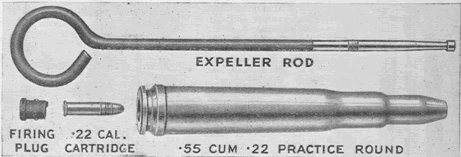
As will be seen by the illustration, this consists of a full size steel container or conveyor, the bore of which is rifled and chambered for the regulation .22 rimfire cartridge and also recessed in the rear of the chamber to receive the rimfire firing plug.
The firing plug is actuated by the striker of the Anti-tank rifle, and with its aid magazine firing practice can be had on the miniature range, the standard of accuracy being about II" circle at 25 yards.
Application for conveyors should be made to the Ministry of Supply, who have undertaken production owing to the Parker-Hale plant being fully occupied.
We have pleasure in reproducing below excerpts from a most interesting article on Firearms for the Home Guard—by Brig.-Gen. A. F. U. Green, C.M.G., D.S.O.—which appeared in " The Rifleman " :‑
"There is no doubt in my mind that the best miniature rifle for training Home Guard is a genuine Service rifle which has been barrelled or rebored or " Parker-rifled," because it handles the same as a Service Rifle."
" We now have authority to get worn barrels Parker-rifled and sights fitted at a price which certainly helps, but does not cover the increasing cost—I hope it is no indiscretion to say that Messrs. Parker-Hale, of Birmingham, who are always most helpful, are undertaking this work at what I consider reasonable prices, though you cannot expect your rifle back under six to eight weeks."
The British Ordnance Board was advised by Parker-Hale of their design for a conveyor early in 1940. An internal memo dated 27th. February that year read as follows
No. 5,747 — SECRET.
270 / Ammunition / 47
RIFLES.
Boys 0.55 inch.
*Parker Hale conveyors for sub-calibre firing.1). of A., 27. 2. 40, to Sec. O.B.
Messrs. Parker Hale's representative recently showed us a 0.55 inch dummy cartridge bored with a short 0.22 inch barrel and fitted with a special striker.
The idea is of considerable interest for training purposes.
Will the Board investigate cartridge devices of this nature for both the Boys rifle and the 15 mm. Besa machine gun.
Priority P* so far as Boys rifle is concerned.Sec. 0.B., 5. 3. 40, to D. of A..
The Board have already arranged to test this device for the Boys rifle, but are informed that Messrs. Parker Hale's have encountered technical difficulties in the manufacture of the conveyor rounds. It is hoped that it will be possible to start the trial in about a fortnight's time. It is not considered that this system is entirely suitable for use in the 15 mm. gun as the operations of extraction and cocking will have to be done by hand For each shot..
If, however, success is achieved in the Boys rifle, the Board will arrange for some 15 mm. conveyor rounds to be manufactured and issued to A.F.V. School for trial.
It will have been seen that the practicality of an equivalent conveyor system for the 15mm BESA gun was also under consideration, and its future would rest on the success, or otherwise, of the system for the Boys ATR.
The comprehensive Trials' Reports memorandi can be viewed separately from this link. These letters date between April and August 1940.
A North American equivalent to the Parker-Hale conveyor was manufactured in Canada by the Cooey Machine & Arms Company.
In his reference book "The Lee-Enfield Story", Ian Skennerton refers to that company producing "77,000 aiming tube conveyors which enabled .22-in. R.F. ammunition to be used in the Boys anti-tank rifle for training". Actually, the Cooey conveyor was not strictly speaking an aiming tube system, which might also have afforded magazine-fed firing practice, and such a sleeve would have been a full-length rifle barrel in its own right, with an outside diameter of a nominal half-inch, that remained in place in the parent barrel during loading.. However, the difference between the Boys' adaptation and the "303" cum 22" conveyor was that the Boys' model had a rifled bore instead of a smoothbore one, and the .303 conveyor for the SMLE fed the .22 bullet into a .22 barrel, although the .303 P-H conveyor for the Vickers machine gun did fire the .22 bullet straight down the .303 barrel - at very short range though. So, what's in a name?.
To recap', the Cooey conveyor - shown right - closely resembled the Parker-Hale design, which also fired the .22 round through the .55 barrel, the bore-length of the conveyor being sufficiently great to approximate the accuracy of a short-barrelled .22RF pistol, perfectly adequate for miniature range use. Although Parker's much earlier version of their ".303 cum .22" conveyor, when used for miniature range practice with the Vickers or Lewis Machine Guns, utilised no tube or sleeve, merely firing the .22RF round through the .303CF barrel's bore; not the most accurate system, even at the twelve yards range at which it was normally used, but most useful for the training and assessment of budding Machine Gun operators.
We illustrate both a drawing of the Cooey conveyor, and a mocked-up sectional representation showing the .22RF cartridge at the approximately correct scale. It will be seen that, like the Parker-Hale version, the Canadian version used a separate firing-plug with double firing-pins to distribute the striker pressure evenly across the rim of the .22RF cartridge. In the past, similar rimfire adaptors have been bored eccentrically to permit striking of the rim by a centre-fire firing pin, but this necessitates constant radial orientation of the adaptor in the parent chamber.

Image by courtesy of the late E. Molyneux

Image by courtesy of the late A.O. Edwards
Another little known training arrangement for Canadian use of the Boys ATR was the adaptation of two obsolete .303 service rifles to replicate the ATR. The first rifle so adapted was the Canadian's own design of straight-pull Ross rifle the bolt action of which bears a realistically close relation to that of the Boys ATR - each being of straight-pull action with a helically operated rotating bolt-head utilising a forward-locking interrupted thread. The second rifle so adapted was the Magazine Lee-Enfield - otherwise long out of service on either side of the Atlantic Ocean.
Again, these training rifles would have permitted comparatively realistic practice on standard military ranges either at the very few hundred yards at which the real ATR would be employed, or on the short 30 yard practice ranges. The use of these converted obsolete rifles would also have prevented the retention of genuine Anti-Tank rifles for training when they were urgently needed elsewhere. This is a factor that, early in the War, may have played a part in the fairly restricted employment of both the .22 adapters and the proposed .55/.303" CF practice round discussed further down this page.
Below is a facsimile of the drawing for the Ross rifle's adaptation, with apologies for the poor and distorted reproduction - reconstructed from a badly torn and crumpled document, and on which we eventually hope to be able to improve.
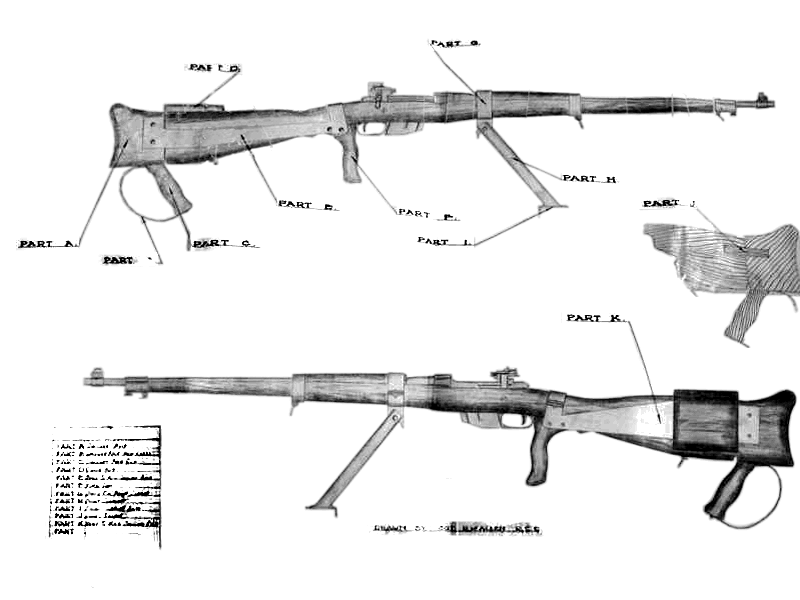
Above, the .303 Ross Service rifle has been given a butt-extension with a curved butt-plate akin to that of the .55 calibre Boys ATR. A bridled sheet-steel support plate for the extension also carries the required pistol-grip behind the trigger-guard of the Ross. A Boys style wooden cheek-piece has been added over the support plate on the left-hand side of the butt-stock, the new extension for which has the hand-hold for the firer's left hand bolted underneath. A Boys-like mono-pod has been fitted to an additional barrel-band forward of the barrel reinforce. Regrettably, the sighting arrangements are not entirely clear in the drawing, and may, or may not, accommodate the left-hand offset to be found on the issued .55" Boys ATR, on which the large top-mounted Bren style magazine interferes with an over-bore sight-line.
A separate cross-sectional side-elevation of the butt, on the right of the drawing, shows "part J" as being a glued wood joining-piece locating the butt-stock extension to the Ross's original butt.
The second adaptation of the Magazine Lee-Enfield rifle. The conversions were undertaken, in early 1942, in the Ordnance Workshops at Esquimalt, the Canadian Forces coastal Base in British Columbia. By the 23rd. of January that year, just five of the converted rifles had been shipped, off issue order reference number 4-2861, to the District Ordnance Officer for the Military District No.7 at Saint John.
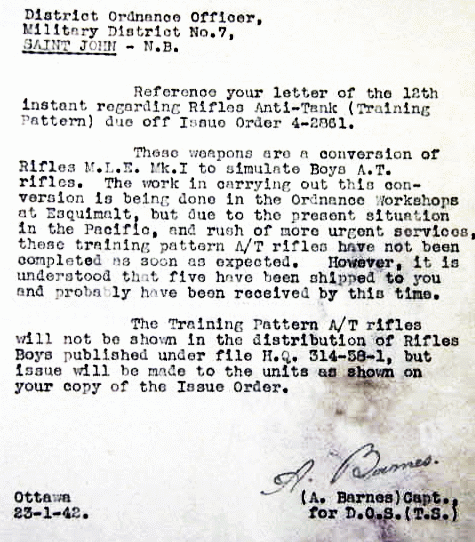
As the letter above declares, other more pressing matters in the Pacific theatre were then delaying production of these obscure training rifles.
Should you hold any information relating to these rifles we would be delighted to hear of it in the interests of our readers.
Please contact
Miniature-Calibre-Rifles@rifleman.org.uk
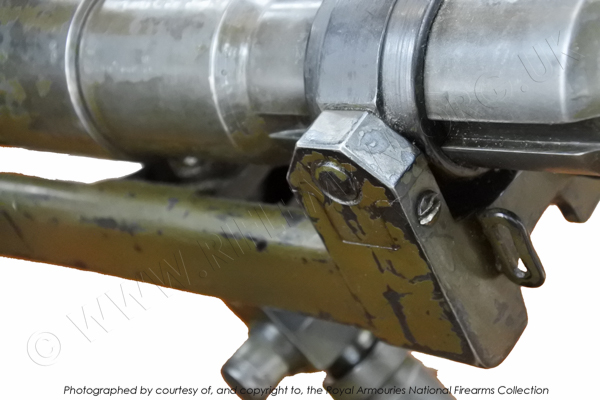
A little known modification to some Boys anti-tank rifles was undertaken in 1940. Both the Allied and Axis forces held significant stocks of various poison gas weapon agents, including the Japanese, who had used mustard gas against the Chinese in Manchuria between the mid 1930s and early in WWII. With the distinct possibility of the deployment of poison gas during WWII, despite their use being banned by the Geneva Convention, many protective systems had been developed. Mustard gas, or its updated version, Lewisite, were the most likely to be used; indeed, even Britain had last resort plans to deploy mustard gas on the coast in the event of an invasion.
Apart from the obvious need to protect personnel from an attack by the use of specialist breathing apparatus and clothing, an ongoing problem was the subsequent decontamination of equipment, which could not be safely handled until washed with a chlorine based solution. Such equipment particularly included small arms, and a specialist neutralising paint was prepared which could be painted onto weapons. The main ingredients were probably chloride of lime and magnesium oxide which provide both absorption and neutralization properties, and were also used as a finely ground decontamination powder for spreading onto polluted articles. One weapon, originally coated in this way, is a Mk.1 Boys anti-tank rifle which is held in the National Firearms Collection. The rifle (ref: PR.1549; serial number B7399) still carries remnants of this unusual green paint.
The US Marine Corps "Raiders", the American equivalent of the British Commandos, carried the British Boys ATR in their clandestine campaigns against and behind Japanese lines in Guadalcanal, the Solomon Islands and other Pacific theatres of World War II between 1942 and 1943. Subsequent to the high-level decision to set up 'special' service raiding units for the Pacific theatre, during mid 1941, two US Officers were sent to observe British Commando units, their training and equipment. The Marine Corps' weapons inventory, as well as their own standard issue Springfield rifle, Thompson sub-machine gun in .45 calibre and the ubiquitous Browning automatic rifle (BAR) became inclusive of the Boys ATR Mk.1* of Canadian issue and Inglis manufacture. Another interesting addition to that inventory, probably directly as a result of that time spent with the Commandos, was their own licensed manufactured Fairbairn-Sykes British Commando dagger to complement the Bowie style knife already issued
One notable action, in which a pair of Boys anti-tank rifles were employed, involved the destruction of two troop-carrying Japanese flying-boats bringing opposition forces to Butaritari to counter the US Marine Corps raid on Makin Island. Both were hit on landing just off-shore, one bursting into flames and the larger four-engined Kawanishi aircraft " made a desperate attempt to take off again, but was riddle by fire as it rose from the water, staggeed and crashed "*
The Boys rifle was also used in early sniping trials by the U.S military, involving examples converted for use with .50 calibre ammunition, presumably because the rifle's configuration was considered possibly to be suitable as a heavy caliber sniper rifle. The conversion involved the fitment of an M2 barrel and a telescopic sight. In his book "Sniper one-on-one", Adrian Gilbert wrote "Reasonably accurate shooting at ranges over a thousand yards was possible" .
It is known that the Boys ATR was used against German midget submarines near the Belgian coast during WWII, where one, returning to base part-surfaced along a canal, was fired on from adjacent cover. The vessel submerged, but the pilot/skipper was found further upstream floating in his lifejacket having abandoned the sinking craft, which had been holed low down in its diminutive "conning tower". An image is shown here of the one-man "Biber" class U-boat type believed to have been involved in the incident.

Two torpedoes were carried, one slung low each side of the craft. A captured example of one of these submarines is to be found in the Imperial War Museum, London.
One of the last recorded combat uses of the Boys ATR was noted by Michael Haugen in his piece entitled Hard Target Interdiction. He wrote
"Another weapon to come out of the Korean war was the Boys Anti-tank rifle converted to .50 caliber by Ralph Walker of Selma Alabama who was stationed on Formosa (Taiwan). The .55 caliber Boys rifle was fitted with a M2 barrel and tested with varied results (mainly due to ammunition). These rifles were used against the Chinese throughout the war with decent results at ranges up to 1100 yards. "
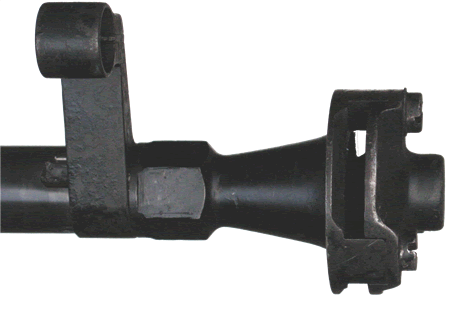
The Mk.I brake was the circular device shown here, with three slots on its circumference at sixty degree spacing. One shortcoming of this design was that it required disassembly for thorough cleaning, needed oiling when not in use, but thorough wiping-out before use. The main problem, however, was that the efflux gasses were direct downwards as well as up and to the side. Whilst dust or other matter could inconveniently be blown into the face of the firer, the fact that a dust cloud could give away the firer's position was even more likely to give him cause for concern. The muzzle-brake of the Mk.I* was a rectangular block with the rear-ward slanting gas vents directed horizontally either side. We hope shortly to be able to bring you images of the later mark.
The image below shows the original .55-in. calibre, proof an inspection marks on the barrel reinforce.
This rifle appears to have been originally manufacture in 1939, and refurbished in 1943.
The BSA Piled Arms logo is just visible low left, with a number of factory inspector's identifying stamps being present.
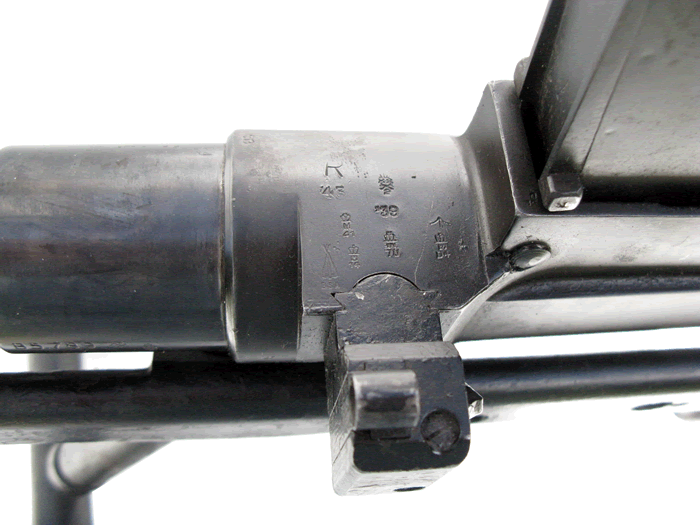
Below left: marks on the receiver,
and right: the rear-sight mounting dovetail in the LHS of the receiver is clearly evident.
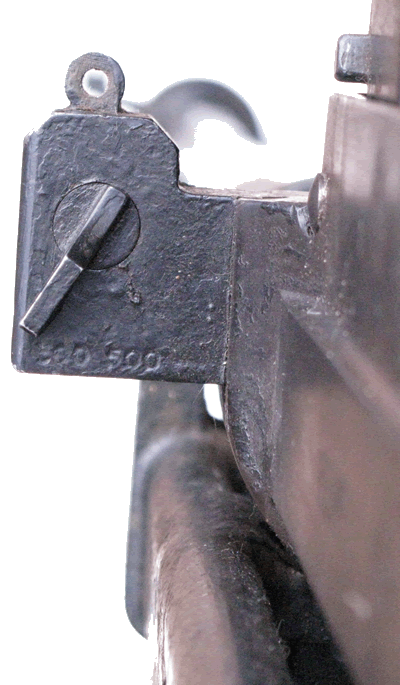
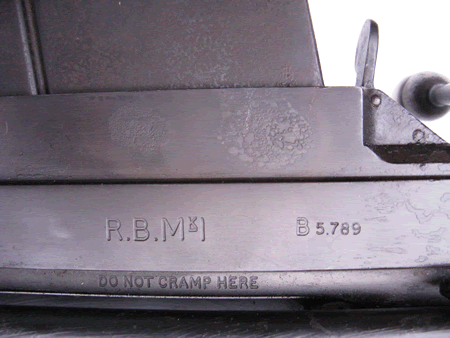
Left, the rifle's designation "R.B.Mk 1" (Rifle, Boys, Mk.I) is heavily stamped into the left-hand frame rail along with its serial number. The magazine release lever is in the upper right of the image with the raised bolt-handle showing behind. The lever is sprung rearwards and only requires a thumb-push forward to release the magazine, which has to be lifted at the rear to remove, it being fitted with locking lugs at the front which engage under a ledge in the receiver's magazine well.
Instructions are cast into the bottom of the receiver to remind armourers not to cramp the action across the open base of the receiver, through which empty cartridge-cases simply drop clear after extraction on opening the bolt after firing.
Below are shown the Boys' bolt, with a .50 calibre Browning round held in the extractor, and a Lee-Enfield No.4 rifle bolt with a .303in. drill-purpose round for comparison. The magazines for both rifles are also at top and bottom of the image. The large ringed cocking-piece permits a good pull to be applied by a finger to counter the considerable weight of the striker spring. It is just large enough to accommodate the finger of a lightly gloved hand, along the lines of the Schmidt-Rubin Swiss service rifle.
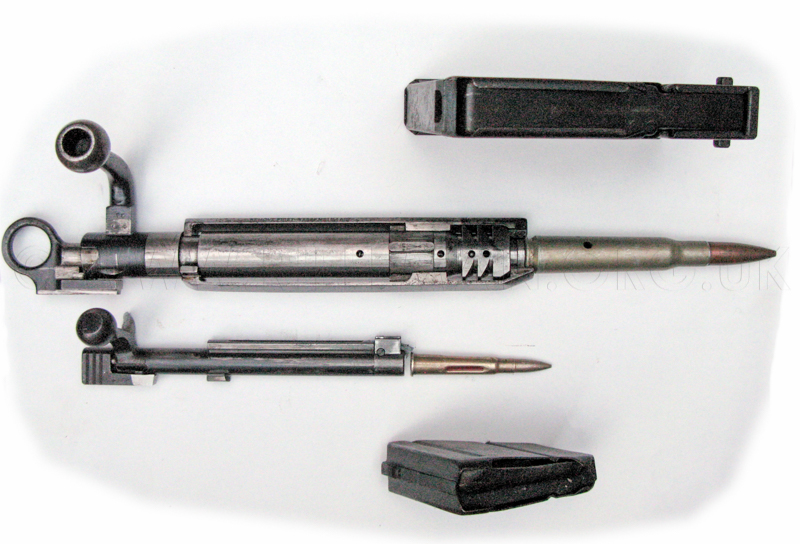
It is also worth comparing the bolt-head of the Boys rifle with that of the .303 'straight-pull' Ross rifle, which is similarly configured with an interrupted-thread forward bolt-locking arrangement.
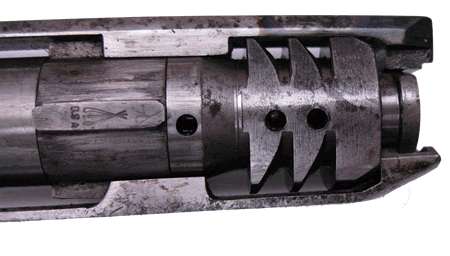
Note the B.S.A. 'Piled Arms' logo stamped into the lug of the bolt-head spacer.

and the specific instructions stamped into the ejector bar - "REMOVE FIRST - ASSEMBLE LAST"
A Mark II rifle was also produced for use by airborne troops, and one can read differing reports as to its calibre. One describes the rifle as using the same .55 calibre case necked down for a .303 calibre armour piercing bullet to increase velocity and penetration, whilst another report states that the .55/.303 round was not developed in an attempt to increase velocity, but as a means to permit training use of the ATR on the great number of standard .303CF rated ranges available. The latter is certainly true, and the subject is covered in detail on the page for the .55/.303 calibre Boys anti-tank training rifle. Whatever the truth of the matter regarding the airborne model's calibres, the Mark II barrel was shortened to 30 inches and the "harmonica" muzzle-brake lightened, but being still of considerable weight, and with even more horrendous recoil, this weapon was practically excluded from advancement into full service. We have made available a page illustrating the Lightened Airborne model of the Boys anti-tank Rifle.
In his book "British Small Arms of World War II" (ISBN 0 949749 09 5) Ian Skennerton quotes figures indicating that the Birmingham Small Arms Company produced just two experimental Boys ATRs in .55/.303 calibre. One was manufactured in December 1942, and the other in July of the following year (although he comments on the possibility of these being one and the same rifle). Additionally, as related in the previous paragraph, a "Boys .55/303 sub calibre rifle" had been produced considerably earlier, in mid December 1938. We have recently been able to record the form that this took, on our new page for the Boys .55/.303 calibre Training Rifle. On the same date, an "Air rifle device for the Boys rifle" was noted to have been produced but details of this unit have yet to be discovered in the Royal Armouries archives, and an example has not been identified in the National Firearms Collection. Should you have any information about this, please contact us.
The very earliest (pre-amendment) 1937 edition of the Small Arms Training Pamphlet No.5 for the Boys Anti-Tank Rifle carries a paragraph on page 6 stating that
"Practice at stationary and snapshooting targets will be carried out on ordinary ranges,
using an adaptation for .303 inch ammunition embodied in the anti-tank rifle".
It goes on to mention "a representative tank target for use with .303-inch ammunition at a range of 100 yards".
We are presently uncertain whether this refers to the .55/303 cartridge above, or to a sub-calibre device utilising the standard service .303 inch CF round. Either way, reference to this usage of .303 calibre ammunition for training was no longer present in the following amended pamphlets.
Only the .22RF Miniature Range practices were subsequently described.
We are able to show the image below of the .55/303 cartridge by courtesy of (the now late) A.O. (Tony) Edwards, author of several publications on British military cartridges and small-arms, to whom we are also indebted for other cartridge data given on this page. (see Bibliography)

At a date yet to be confirmed, but presumably prior to the issue of the Mk.I* rifle, two experimental Boys rifles were produced by B.S.A. in 13.2 mm calibre (at 0.7mm less than the original Boys calibre, this was the same calibre in which the original German Mauser Tank-Gewehr Model 1918 was manufactured, thirty years earlier, to counter the introduction of the First World War tanks of the British Army to the French and Belgian battlefields). Of these two rifles, not put into production, one remains in the collection of the Imperial War Museum and the other is in private hands. We are grateful for the permission of the owners (Conjay - Collectors' Weapons) to illustrate this extremely rare Mark I rifle, marked with the calibre 13.2mm. This particular example was passed by B.S.A. to the Kynoch Ammunition Company for testing of the  13.2mm ammunition, more of which we hope to be able to write at some time in the future. It is believed this 13.2mm round was an offshoot of the 15mm BESA Machine Gun ammunition. We have heard reports that the round was being developed for use on aircraft of bomber command, perhaps in conjunction with the Mk.II air-portable rifle (although any prospect of firing the rifle accurately from an aircraft is extremely doubtful). There has been a suggestion that, with German fighters having armour fitted behind the pilots seats, it was proposed that an ATR be mounted somewhere on the Lancaster, to provide retaliation against attacking fighters departing after a pass or perhaps even in head-on attack when the engine block was most vulnerable. Such stories often have an element of truth, because almost every angle of improving or adding to defence and attack capability was investigated in war-time, and although many bright ideas never left the drawing board, many also reached prototyping and trialling, although impracticalities or economics subsequently caused them to fade into obscurity. As practicalities go, using a single-shot rifle for such a purpose seems fairly extreme....... but war can require extreme measures. Tony Edwards has kindly provided an image of what is believed to be the 13.2 round's head-stamp, the calibre marking of which is clearly shown, above right, as being 13.3 M/M. There is no record, in Ian Skennerton's quoted figures, of separate BSA production of these 13.2 or 13.3mm calibre trials weapons, although there is note of an unusual experimental Boys smoothbore barrel being manufactured in mid 1945. There is just a possibility that this may have been for testing a saboted round, as examples of such a round exist; whether these would have proved sufficiently accurate when fired from an unrifled barrel is questionable, but the range distances at which the Boys was most expected to be used were usually between only 100 and 400 yards.
13.2mm ammunition, more of which we hope to be able to write at some time in the future. It is believed this 13.2mm round was an offshoot of the 15mm BESA Machine Gun ammunition. We have heard reports that the round was being developed for use on aircraft of bomber command, perhaps in conjunction with the Mk.II air-portable rifle (although any prospect of firing the rifle accurately from an aircraft is extremely doubtful). There has been a suggestion that, with German fighters having armour fitted behind the pilots seats, it was proposed that an ATR be mounted somewhere on the Lancaster, to provide retaliation against attacking fighters departing after a pass or perhaps even in head-on attack when the engine block was most vulnerable. Such stories often have an element of truth, because almost every angle of improving or adding to defence and attack capability was investigated in war-time, and although many bright ideas never left the drawing board, many also reached prototyping and trialling, although impracticalities or economics subsequently caused them to fade into obscurity. As practicalities go, using a single-shot rifle for such a purpose seems fairly extreme....... but war can require extreme measures. Tony Edwards has kindly provided an image of what is believed to be the 13.2 round's head-stamp, the calibre marking of which is clearly shown, above right, as being 13.3 M/M. There is no record, in Ian Skennerton's quoted figures, of separate BSA production of these 13.2 or 13.3mm calibre trials weapons, although there is note of an unusual experimental Boys smoothbore barrel being manufactured in mid 1945. There is just a possibility that this may have been for testing a saboted round, as examples of such a round exist; whether these would have proved sufficiently accurate when fired from an unrifled barrel is questionable, but the range distances at which the Boys was most expected to be used were usually between only 100 and 400 yards.

Above image by kind permission of Conjay - Collectors' Weapons - Newport, Gwent.
Production of all marks of Boys ceased in the Autumn of 1943 with the introduction of the new infantry anti-tank projector. The P.I.A.T (Projector, Infantry, Anti-Tank) was only a few pounds lighter than the Boys, which weighed in at close on 39 lbs. with a full 5 round magazine, but nearly two feet shorter at 39 inches. The shaped charge projectiles, whilst bulky and heavy compared with the .55 calibre ammunition for the Boys, were dramatically more effective, particularly on heavy armour. Compare the PIAT's near 100 mm maximum penetration against the Boys' 23 mm, both at 100 yards. The figures for the Boys can be found in the manual - linked below.
It has been commented upon in an unidentified article that the Boys ATR was considered obsolete by 1943, and, at a time when morale was deemed to be at an ebb within the Home Guard, 100,000 of these rifles were issued to these units for use in the event of an invasion; although any such threat had by now much receded. In his fine reference book " The Lee-Enfield Story", Ian Skennerton quotes the British total figure of Boys units manufactured in the U.K. between 1941 and 1945 as 50,611. For the Home Guard issue figure to be correct there would have needed to be well in excess of 50,000 manufactured between 1937 and 1940, unless Canadian production was included in that issue. It also should not be forgotten that considerable numbers of these rifles remained in Northern France and on the beaches around Dunkirk, along with huge quantities of other matériel, after the mid 1940 evacuation.
Links to the BOYS ATR - MANUAL .................. SAT PAMPHLET No.5 ......................... RANGE COURSE
The pull-out colour sheet below was included with the Gale and Polden Manual for the Mk.I rifle.
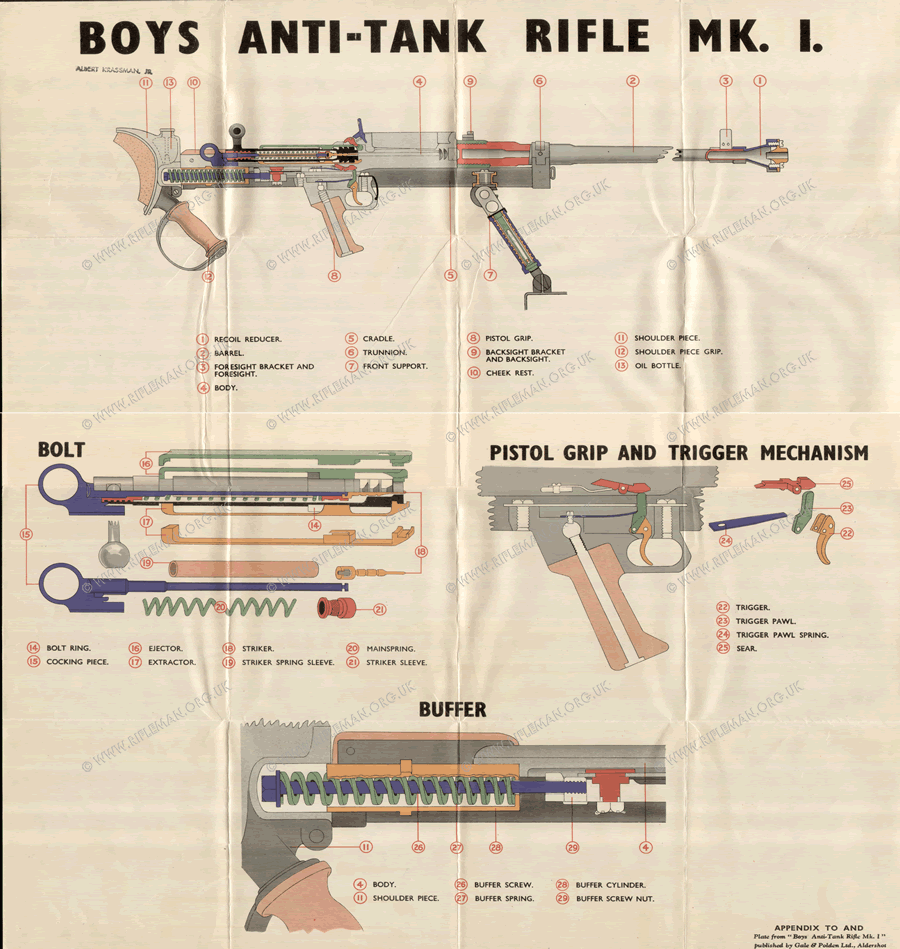
Below are the D.D.(E). [Enfield Drawings] for both the Mk.I Rifle and its accessories.
Hover over or Click image to bring up hi-res file and magnifier
Hover over or Click image to bring up hi-res file and magnifier
The BOYS ATR Mk.I*
Below is shown the later Boys ATR Mk.I* with the bi-pod support replacing the inverted "T" mono-pod,
..........................................................................and the "Harmonica" muzzle-brake replacing the Mk.I's circular type.
The rifle shown below is of Canadian manufacture at the Inglis Works. It was for this rifle that the Canadian Government asked Walt Disney to produce a training film.
The video clips of this can be viewed at the bottom of this page.
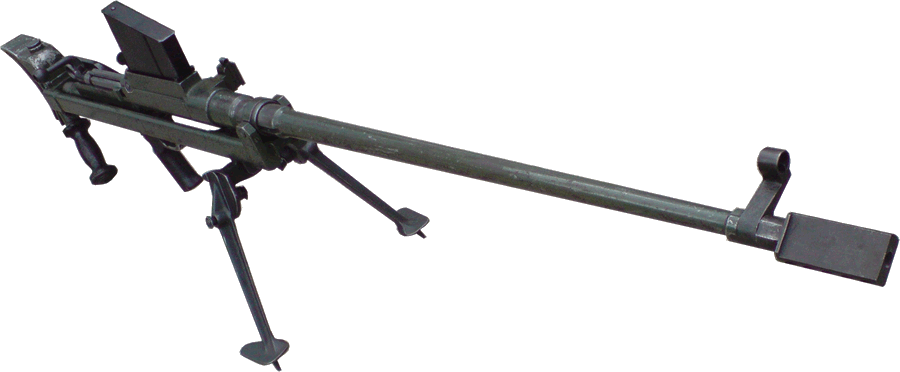
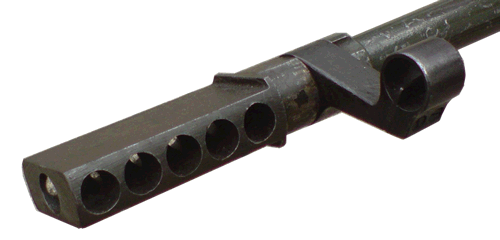
This new muzzle-brake had five apertures angled backward to direct expelled gasses against the recoil of the rifle on firing. The early circular version expelled gas all round its periphery, including at the ground, where it would create a dust or other cloud of debris that could both give away the firer's position and drive grit or mud into his eyes. The new 'brake' directed the gas horizontally left and right.
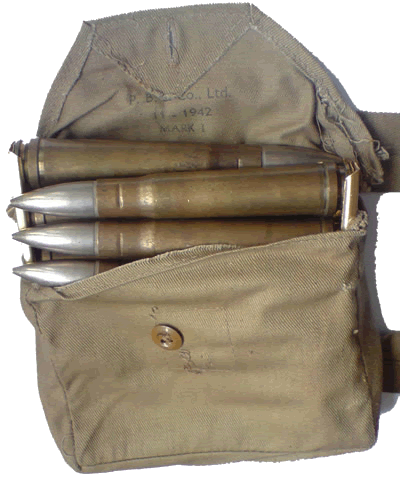
The .55 calibre ammunition was available as the main purpose armour-piercing round with a tungsten-cored bullet, as well as with a tracer bullet. There was also an aluminium-cored bullet for training where the butts on a range would not take kindly to the AP ammunition.
In addition to the AP rounds, there were also three marks of ball ammunition, and these were intended for both training and for use against “soft” targets such as vehicles not carrying armour. Even this was too dangerous to use on most ranges, so two marks of practice ammunition were introduced, the Mark I in 1937 and the Mark II in 1938. The Mark I was a down-loaded ball round with a lead-cored Mark I ball bullet and it was the Mark II that had the aluminium cored bullet.
The AP bullet weighed 926 grains (although it has also been reported as weighing 47.6 grammes = 735 grains), compared with the 146 grains of the Lee-Enfield .303" calibre Service Rifle bullet. Reloaded non AP ammunition is we hear currently being assembled in the U.S. with 480 grain bullets for 'plinking'.
Muzzle velocity with the original AP round is 3250 feet/sec. (990 m/s). For the training rounds, Tony Edwards provided the data following.
Mark I -
Mark I ball bullet with lead core, weight 930 grns, charge 103 grns Cordite MDT 5-2, MV 1729 fps.
Mark II -
Aluminium cored bullet, weight 425 grns, charge 128 grns Cordite MDT 5-2, MV 2650 fps.

The belted case head can be seen clearly in the image to the right.
To the left is the cloth pouch with a light-weight looped carrying-strap (out of picture).
This pouch held two clips of five rounds each - two magazine fills.
To the right are basic maintenance and cleaning tools. The oil-brush shows its threaded wooden top which screws into the underside of the metal lid for the oil-bottle integral with the butt-plate. The box spanner is for the recoil-spring retaining nut in the frame rear covered by the butt-plate, shown below right. The gauze cleaning pad is used with the folding cleaning-rod or a pull-through. These will be seen in the manual for the rifle as will details of the penetrative capabilities of the Boys bullet and other relevant information.

The issued spanner is specifically marked
for the " Rifle, Boys, Mk.I* "


An interesting anecdote was included in a report on Mission 101 - the Operational Centres: the hidden Australian involvement in Ethiopia - WW2, and the formation of the Special Operations Executive, "SOE".
The report starts by noting that
.......................................... "Mission 101 started its days as a covert operation planned by Britain's Military Intelligence community MI(R). The Mission was designed to open a second front in North Africa by inciting rebellion against the Italian occupiers of Ethiopia with the objective of re-installing the Ethiopian Emperor, Haile Sellaisse, onto the Ethiopian throne. Undoubtedly part of the motivation for Mission 101 was the appeasement of a disillusioned British population who had, in general, never accepted the British political acquiescence to the Italian invasion of 1935/6. Mission 101 ended its days as Gideon Force, which was part of the Allied invasion force that eventually entered the Ethiopian Capital, Addis Abebba in May 1941, thereby ending the Italian colonial era."
Later in the notes are specifics relating to the mission, and a concluding anecdote which reminds us that the Boys rifle actually acquired the nick-name "Elephant Gun", rather because of its size and weight than for any reason to do with its capability for bringing down such an animal; however ....................
"Allied forces in the Horn of Africa and the Middle East were under the control of General Archibald Wavell who seems to have been the originator of the scheme. He called Sandford out of retirement in August 1939, promoted him to Colonel and appointed him in charge of the Ethiopian Section within Middle Eastern Intelligence (M12). Sandford put together a team comprising Capt R A Critchley (GSO3) (8), A/Major D H Nott (DAA&QMG), A/Capt T M Foley (Royal Engineers), A/Capt C B Drew (surgeon and medical officer), S/Sgt (later CSM) G S Grey (radio specialist), Maj Count A W D Bentinck (GSO2), 2nd Lt A Wienholt (Intelligence Office), S/Sgt G S Rees and Cpl Frost. Despite detailed planning having begun as early as January 1940, official appointments were delayed, for political reasons until Italy entered the war on the 10 June 1940. (9) Wienholt who was in Aden at the time immediately flew to Karthoum, arriving there on the 20 June to join Mission 101.
The plan called for a number of "Operational Centres" to be set up under British or Australian officers who together with four NCOs and a group of some thirty Ethiopians would infiltrate into Ethiopia. (10) There they would attach themselves to various guerrilla groups operating within that country to act as coordinators and to supply the guerrillas with arms and advice. The Mission's objective being to stir up popular revolts so that the Emperor would be able to return.
The first of these Operational Centres, called the No. 1 (Australian) Operational Centre was sent into Ethiopia's Gojjam Province in mid 1940. (11) This unit, sometimes called Brown's No. 1 Intelligence and Operational Centre, was under the command of Lt Allan H. Brown formerly of the 2nd/1st Field Regiment, Division supported by Sgts W.R. Howell, R.C. Wood, E.M. Body and J.K. Burke. (12)
The Ethiopian component of Brown's No. 1 Operational Centre was made up from elements of the 1st Ethiopian Battalion, recruited inside the Sudan (13). This Battalion was considered to be of "indifferent quality" and was disbanded, the better elements of it being assigned to Brown.
Brown's Operational Centre was infiltrated into Ethiopia in the vicinity of Dinder. Dodds-Parker was to later note of them that;
"They were to add distinction to the ANZAC reputation for bravery and endurance."
He also noted that:
"I had one other difficulty with them. Months later a letter arrived from the Game Warden's Office, saying that they had shot, without a licence, a giraffe with a Bren gun and an elephant with a Boys anti-tank rifle. The fine was 5.14 [pounds sterling]. It was the success of these Operational Centres that led to them being the modus operandi of the SOE in the Balkans and Italy. "
Report ends.
* "NEW ZEALAND ENGINEERS, MIDDLE EAST" by J.F. Cody - Chapter III - In the Lee of the Storm.
The Boys anti-tank rifle was unsurprisingly employed in armoured cars very early in the Second World War. The surprising aspect of this was that they were to be found fitted in the manually rotated turrets of Rolls-Royce armoured cars such as those famously used by T.E. Lawrence (Lawrence of Arabia) in the desert campaign during the First World War. These armoured vehicles were put into use by the 11th. Hussars, doing similar scouting and very occasional raiding work to Lawrence, but mainly against the Italians in the Egyptian desert.
Such armoured vehicles were late and post WW1 models modified to the 1922 and 1924 patterns, some of which had their turrets modified in Cairo to add the Boys ATR and Bren LMG, either to, or in place of, their Vickers MG armament.
A well publicised German propaganda photograph depicted Rommel viewing a 'knocked-out' RR armoured car at Antelat in Cyrenaica as late as January 1942. The AFV was originally built in 1922, and Rommel appears to be showing amazement that such an obsolete vehicle could still be in use by British Forces. Another photograph of the scene shows one of the rear tyre still in flames.
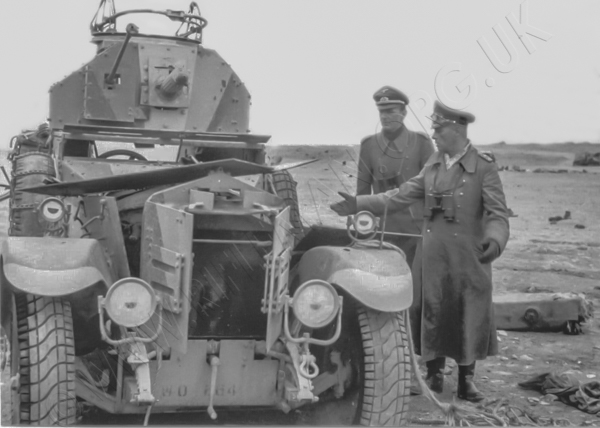
By 1940, the new Morris CS9 armoured car had already been introduced, with a similar weapons fit, and is was not long after this photograph was taken that the outdated Rolls-Royce models were withdrawn. A small number did remain active back in the U.K. with the Home Guard for anti-parachutist patrol work.
The Morris Light Reconaissance Vehicle also carried the Boys ATR, but often unmounted.
The well-known Long Range Desert Group -or "Desert Rats" - used the Boys ATR in addition to their Bren, Lewis and Browning machine guns. They operated, as 'Desert Raiders', in comparatively small patrols in the Libyan Desert covering thousands of miles in sorties lasting weeks at a time, without outside support, and using a number of especially prepared vehicle types and configurations.

On patrol, their only means of communication with the outside world was by radio, and that was subject to enemy direction-finding pinpointing their positions.
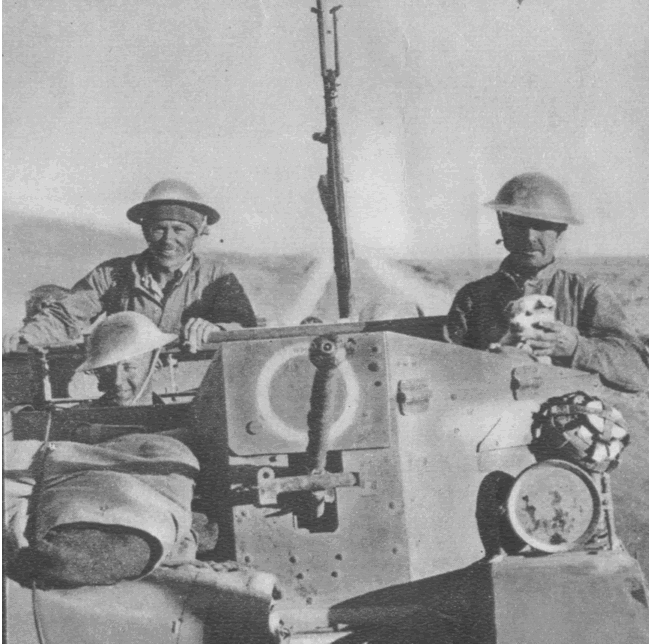

Above left, the Boys ATR is mounted on a Bren-gun carrier, ......................................
...................... and right, The radio operator keys in a morse message via the radio set on his truck, shown above descending from the brow of a sand dune.
The images above are from a War Office Ministry of Information booklet detailing the "Destruction of an Army"
- The First Campaign in Libya September 1940 to February 1941
This refers to the defeat of the Italian Army in North Africa and the capture of over 80,000 troops.
Links to the BOYS ATR - MANUAL .................. SAT PAMPHLET No.5 ......................... RANGE COURSE

The above details are taken from 'Military Small Arms in Finland 1918-1988' by Markku Palokangas, Vol 3 1991, Suomen Asehistoriallinen Seura oy, ISBN951-25-0519-3.
It is stated that the Boys ATRs were first used by infantry units (there is a picture of ski troops with the Boys carried muzzle-down on a back-pack with the pistol-grip just below the nape of the neck. The carrier would have had to keep an eye out for low branches, and, if it was slung on MY back whilst I was on skis I'd simply fall flat on my back - or face - depending on whether I was facing up or downhill!: Ed) By comparison, a US marine is pictured in the USMC Raiders book* carrying a Boys on his shoulder in a 'sloped arms' position, whilst Tommies - apart from the one in the wartime propaganda poster shown left - are sometimes to be found pictured carrying their ATRs at the trail, but with some manner of carrying strop or handle) The photograph shows some sort of canvas or leather cover for the action. If canvas, it could well have been the standard British issue canvas and webbing item shown in the SAID Drawing of the Boys Accessories).
The rifles were apparently later issued to coastal defence units, and it is also possible that a few more were acquired, but the remaining 330 were sold off in 1956.
The Finns also had Polish Vzor 30, German T-Gew M18 (though these do not appear to have been issued for combat) and captured Russian PTRD and PTRS ATRs (both in very small quantities) .
In October 1942, Popular Science magazine included an article, typically heavy on propaganda for the time, on the Canadian Boys rifle manufactured by the Inglis company. We replicate this below.
"MOVIE CARTOONS SHOW HOW AN ANTI-TANK GUN WORKS
Walt Disney's Animated Art Quickly Teaches Soldiers Details of Caring for and Using Canada's MKI Rifle.
• •
In the field the MK.I can be handled by one man in combatting tanks. Cartoon movies of it in action, with close-ups of its working parts, do much to speed the training of the men who use it.
A TWO-REEL moving picture, produced by the Walt Disney studios as part of Mickey Mouse's war effort, is being used with great success in training soldiers to operate the famous Canadian anti-tank rifle, the Boys Mk.I. Combining both live action and cartoon animation, the film reveals every important detail of setting up, camouflaging, aiming, and firing the gun, with some sequences repeated for emphasis.
 .....
..... 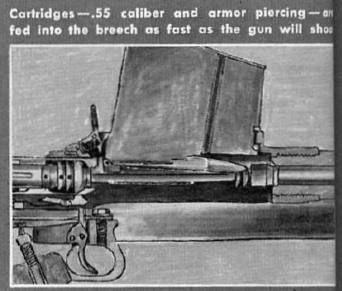
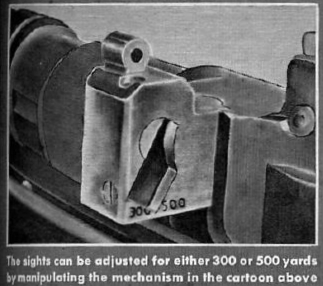 .....
..... 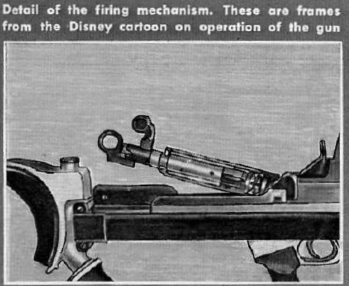
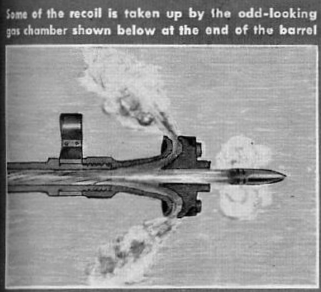 ....
.... 
